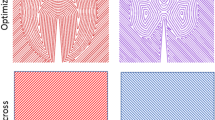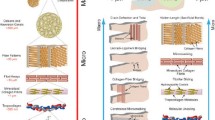Abstract
Natural materials (e.g. nacre, bone, and spider silk) exhibit unique and outstanding mechanical properties. This performance is due to highly evolved hierarchical designs. Building a comprehensive understanding of the multi-scale mechanisms that enable this performance represents a critical step toward realizing strong and tough bio-inspired materials. This paper details a multi-scale experimental investigation into the toughening mechanisms in natural nacre. By applying extended digital image correlation and other image processing techniques, quantitative information is extracted from otherwise prodominantly qualitative experiments. In situ three point bending fracture tests are performed to identify and quantify the toughening mechanisms involved during the fracture of natural nacre across multiple length scales. At the macro and micro scales, fracture tests performed in situ with a macro lens and optical microscope enable observation of spreading of damage outward from the crack tip. This spreading is quantified using an iso-contour technique to assess material toughness. At the nanoscale, fracture tests are performed in situ an atomic force microscope to link the larger-scale damage spreading to sliding within the tablet-based microstructure. To quantify the magnitude of sliding and its distribution, images from the in situ AFM fracture tests are analyzed using new algorithms based on digital image correlation techniques which allow for discontinuous displacement fields. Ultimately, this comprehensive methodology provides a framework for broad experimental investigations into the failure mechanisms of bio- and bio-inspired materials.

















Similar content being viewed by others
References
Sarikaya M, Aksay IA (eds) (1995) Biomimetics, design and processing of materials. Woodbury, NY
Mayer G (2005) Rigid biological systems as models for synthetic composites. Science 310:1144
Buehler MJ, Ackbarow T (2007) Fracture mechanics of protein materials. Mater Today 10:46
Ashby MF, Gibson LJ, Wegst U, Olive R (1995) The mechanical properties of natural materials. I. Material property charts. Proc Math Phys Sci 450:123
Gao HJ, Ji BH, Jager IL, Arzt E, Fratzl P (2003) Materials become insensitive to flaws at nanoscale: lessons from nature. Proc Natl Acad Sci USA 100:5597
Currey JD (1977) Mechanical properties of Mother of Pearl in tension. Proc R Soc Lond 196:443
Currey JD, Taylor JD (1974) The mechanical behavior of some molluscan hard tissues. J Zool (London) 173:395
Wegst U, Ashby M (2004) The mechanical efficiency of natural materials. Philos Mag 84:2167
Barthelat F, Espinosa HD (2007) An experimental investigation of deformation and fracture of nacre-mother of pearl. Exp Mech 47:311
Lin A, Meyers MA (2005) Growth and structure in abalone shell. Mater Sci Eng A-Struct Mater Prop Microstruct Process 390:27
Su XW et al (2002) Structural and microstructural characterization of the growth lines and prismatic microarchitecture in red abalone shell and the microstructures of abalone “flat pearls”. Chem Mater 14:3106
Espinosa H, Rim J, Barthelat F, Buehler MJ (2009) Merger of structure and material in nacre and bone-perspectives on de novo biomimetic materials. Prog Mater Sci 54:1059
Launey M, Ritchie R (2009) On the fracture toughness of advanced materials. Adv Mater 21:2103–2110
Espinosa HD et al. (2011) Tablet-level origin of toughening in Abalone shells and translation to synthetic composite materials. Nature communications. doi:10.1038/ncomms1172
Wang RZ, Suo Z, Evans AG, Yao N, Aksay IA (2001) Deformation mechanisms in nacre. J Mater Res 16:2485
Ren F, Wan X, Ma Z, Su J (2009) Study on microstructure and thermodynamics of nacre in mussel shell. Mater Chem Phys 114:367
Meyers M, Lin A, Chen P, Muyco J (2008) Mechanical strength of abalone nacre: role of the soft organic layer. J Mech Behav Biomed Mater 1:76
Evans AG et al (2001) A model for the robust mechanical behavior of nacre. J Mater Res 16:2475
Song F, Bai YL (2003) Effects of nanostructures on the fracture strength of the interfaces in nacre. J Mater Res 18:1741
Smith BL et al (1999) Molecular mechanistic origin of the toughness of natural adhesives, fibres and composites. Nature (London) 399:761
Barthelat F, Li CM, Comi C, Espinosa HD (2006) Mechanical properties of nacre constituents and their impact on mechanical performance. J Mater Res 21:1977
Li XD, Huang Z (2009) Unveiling the formation mechanism of pseudo-single-crystal aragonite platelets in nacre. Phys Rev Lett 102:1
Bruet BJF et al (2005) Nanoscale morphology and indentation of individual nacre tablets from the gastropod mollusc Trochus niloticus. J Mater Res 20:2400
Grégoire D, Maigre H, Morestin F (2009) New experimental techniques for dynamic crack localization. Eur J Comput Mech 18:255
Clegg WJ, Kendall K, Alford NM, Button TW, Birchall JD (1990) A simple way to make tough ceramics. Nature 347:455
Mayer G (2006) New classes of tough composite materials: lessons from natural rigid biological systems. Mater Sci Eng C Biomim Supramolec Syst 26:1261
Tang ZY, Kotov NA, Magonov S, Ozturk B (2003) Nanostructured artificial nacre. Nat Mater 2:413
Podsiadlo P et al (2007) Ultrastrong and stiff layered polymer nanocomposites. Science 318:80
Bonderer LJ, Studart A, Gauckler L (2008) Bioinspired design and assembly of platelet reinforced polymer films. Science 319:1069
Chen L, Ballarini R, Kahn H, Heuer AH (2007) A bioinspired micro-composite structure. J Mater Res 22:124
Zhang X, Liu C, Wu W, Wang J (2006) Evaporation-induced self-assembly of organic–inorganic ordered nanocomposite thin films that mimic nacre. Mater Lett 60:2086
Munch E et al (2008) Tough, bio-inspired hybrid materials. Science 322:1516
A. S. T. M. Standard E1820-01 (2001) Standard test method for measurement of fracture toughness. ASTM International
Barthelat F, Tang H, Zavattieri PD, Li CM, Espinosa HD (2007) On the mechanics of mother-of-pearl: a key feature in the material hierarchical structure. J Mech Phys Solids 55:306
Sutton MA, Cheng MQ, Peters WH, Chao YJ, Mcneill SR (1986) Application of an optimized digital correlation method to planar deformation analysis. Image Vis Comput 4:143
Sutton MA, Wolters W, Peters WH, Ranson W, Mcneill SR (1983) Determination of displacements using an improved digital correlation method. Image Vis Comput 1:133
Touchal-Mguil S (1997) (In French) Une technique de corrélation d'images numériques: application à la détermination de courbes limites de formages et proposition d'un critère de striction. INSA-LYON, France
http://icasoft.insa-lyon.fr, Icasoft, Morestin in LaMCoS, INSA-Lyon.
Moes N, Dolbow J, Belytschko T (1999) A finite element method for crack growth without remeshing. Int J Numer Methods Eng 46:131
Gregoire D, Maigre H, Combescure A (2009) New experimental and numerical technique to study the arrest and the restart of a crack under impact in transparent materials. Int J Solids Struct 46:3480
Poissant J, Barthelat F (2010) A novel “subset splitting” procedure for digital image correlation on discontinuous displacement fields. Exp Mech 50:353
Réthoré J, Hild F, Roux S (2008) Extended digital image correlation with crack shape optimization. Int J Numer Methods Eng 73:248
Grégoire D, Maigre H, Fabis J, Combescure A (to be submitted, 2010) New experimental techniques for crack location and fracture parameters estimation in non-transparent materials. Exp Mech
Acknowledgments
HDE acknowledges the support by the National Science Foundation through award No. CMS-0301416, ARO-MURI Award No. W911NF-08-1-0541, ONR awards N00014-08-1-0108, N00014-08-1-1055, and General Motors Company through contract No. TCS10643. Carla Shute (Northwestern University) is gratefully acknowledged for her advice concerning the nacre sample preparation. D.G. is grateful to the French Ministry of Defense (DGA/D4S) for its support through grant No. 0860021 to visit Northwestern University as a research associate. O.L. acknowledges the Northwestern University Presidential and Ryan Fellowships.
Author information
Authors and Affiliations
Corresponding author
Rights and permissions
About this article
Cite this article
Grégoire, D., Loh, O., Juster, A. et al. In-situ AFM Experiments with Discontinuous DIC Applied to Damage Identification in Biomaterials. Exp Mech 51, 591–607 (2011). https://doi.org/10.1007/s11340-011-9463-6
Received:
Accepted:
Published:
Issue Date:
DOI: https://doi.org/10.1007/s11340-011-9463-6




